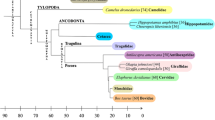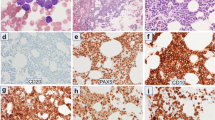Abstract
The cell line B95-8 releases Epstein–Barr virus (EBV) with high titres of transforming activity and is widely used as a model in cancer research and virology. There are, however, controversial reports about the species of origin, cell line stability and karyotype. To address these questions, B95-8 chromosomes were analysed by chromosome sorting and painting by multicolour fluorescence in-situ hybridization. Reciprocal painting was performed between B95-8, ‘wildtype’ New World monkey and human chromosomes. Saguinus oedipus was revealed as the species of origin. A further five cell-line-specific marker chromosomes, resulting from translocations, deletions and an insertion were found. Although human chromosome 6 or 13 homologues were always involved in these rearrangements, co-hybridization of an EBV-specific DNA probe did not reveal site-specific hybridization to marker chromosomes or at translocation breakpoints. The multicolour probe set described here will be of special value for further evolutionary studies in New World monkeys.
Similar content being viewed by others
References
Miller G, Lipman M (1973) Release of infectious Epstein-Barr virus by transformed marmoset leukocytes. Proc Natl Acad Sci USA 70: 190–194.
Miller G, Shope T, Lisco H, Stitt D, Lipman M (1972) Epstein-Barr virus: transformation, cytopathic changes, and viral antigens in squirrel monkey and marmoset leukocytes. Proc Natl Acad Sci USA 69: 383–387.
Müller S, O'Brien PC, Ferguson-Smith MA, Wienberg J (1998) Cross-species colour segmenting: a novel tool in human karyotype analysis. Cytometry 33: 445–452.
Müller S, Stanyon R, O'Brien PC, Ferguson-Smith MA, Plesker R, Wienberg J (1999) Defining the ancestral karyotype for all primates by multidirectional chromosome painting between tree shrews, lemurs and humans. Chromosoma 108: 393–400.
Nagamachi CY, Pieczarka JC, Schwarz M, Barros RM, Mattevi MS (1997) Comparative chromosomal study of five taxa of genus Callithrix, group jacchus (Platyrrhini, Primates). Am J Primatol 41: 53–60.
Neitzel H (1986) A routine method for the establishment of permanent growing lymphoblastoid cell lines. Hum Genet 73: 320–326.
Ried T, Baldini A, Rand TC, Ward DC (1992) Simultaneous visualization of seven different DNA probes by in situ hybridization using combinatorial fluorescence and digital imaging microscopy. Proc Natl Acad Sci USA 89: 1388–1392.
Telenius H, Pelmear AHP, Tunnacliffe A et al. (1992) Cytogenetic analysis by chromosome painting using DOP-PCR amplified flow-sorted chromosomes. Genes Chromosomes Cancer 4: 257–263.
Author information
Authors and Affiliations
Rights and permissions
About this article
Cite this article
Müller, S., Neusser, M., O'Brien, P.C.M. et al. Molecular cytogenetic characterization of the EBV-producing cell line B95-8 (Saguinus oedipus, Platyrrhini) by chromosome sorting and painting. Chromosome Res 9, 689–693 (2001). https://doi.org/10.1023/A:1012960525326
Issue Date:
DOI: https://doi.org/10.1023/A:1012960525326




